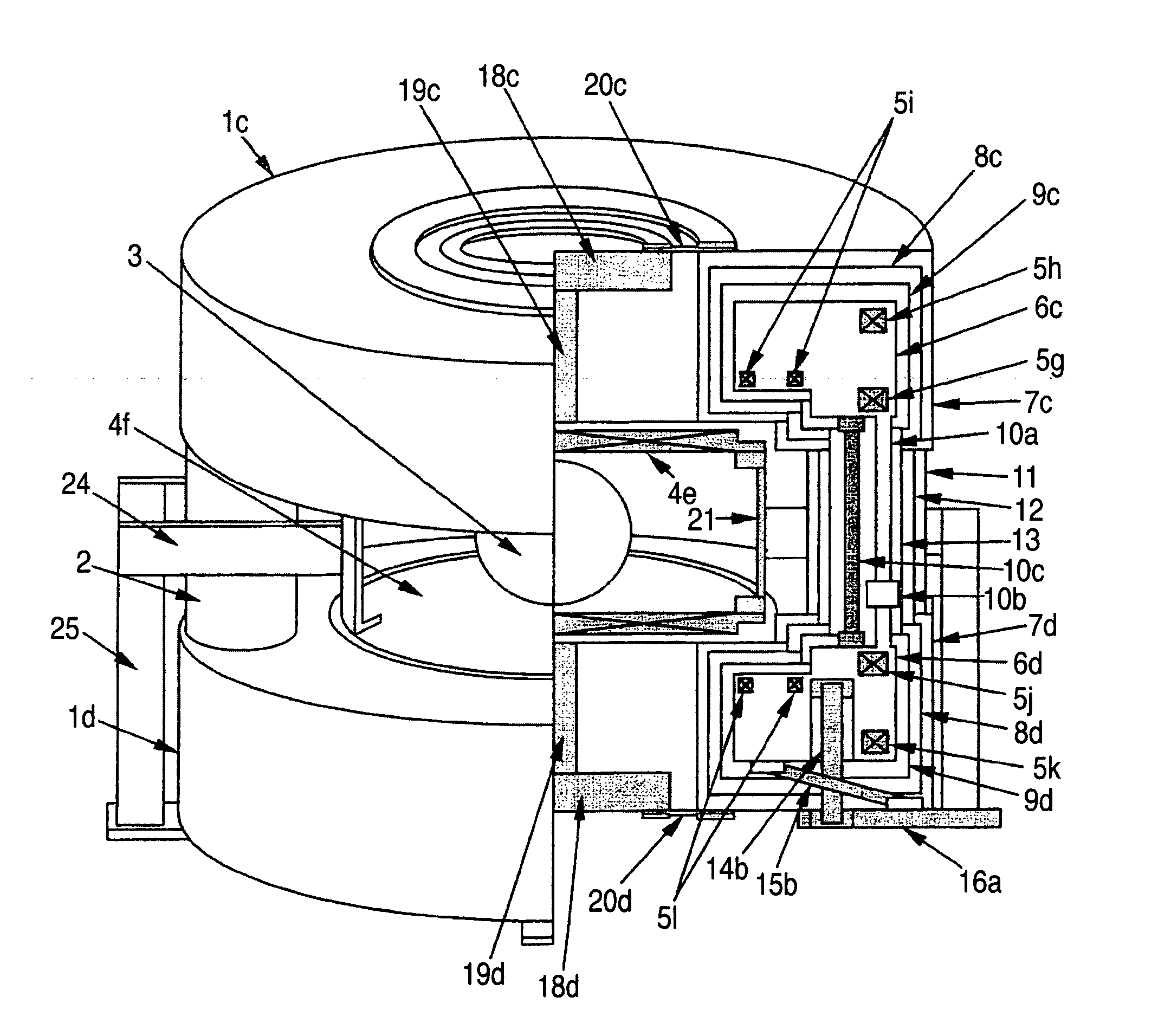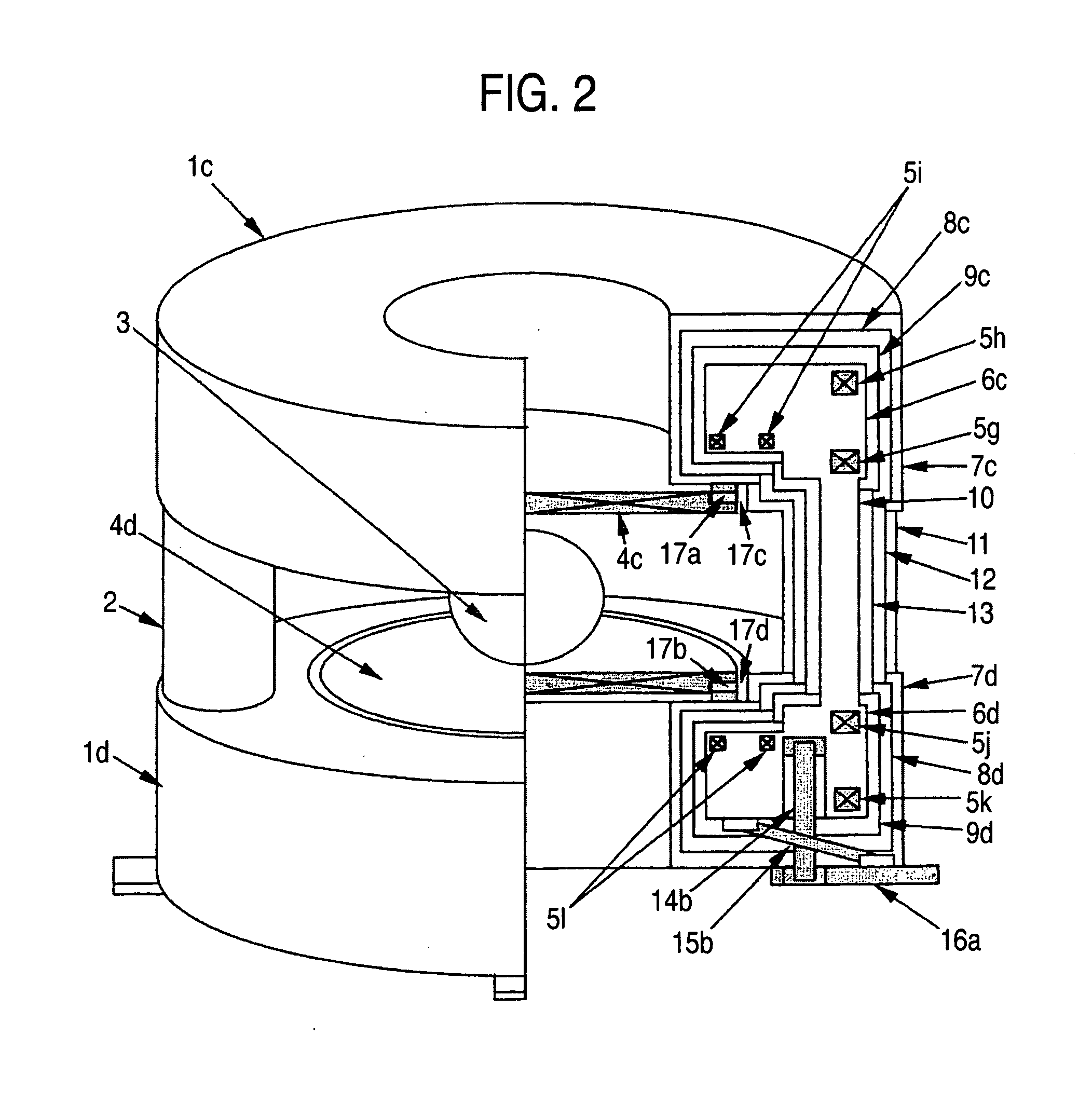Superconducting magnet apparatus for MRI
a magnet apparatus and superconducting technology, applied in the direction of superconducting magnets/coils, instruments, magnetic bodies, etc., can solve the problems of deteriorating mr image (magnetic resonance image), inability to resist a large electromagnetic force, and inducing mechanical oscillation, etc., to achieve high-quality mr image and reduce the effect of magnetic field oscillation
- Summary
- Abstract
- Description
- Claims
- Application Information
AI Technical Summary
Benefits of technology
Problems solved by technology
Method used
Image
Examples
first embodiment
[0022] A first embodiment of the invention will now be described with reference to FIG. 1.
[0023] Referring to FIG. 1, alpha-numerals 1a and 1b denote, respectively, a top superconducting magnet and a bottom. superconducting magnet of an almost annular shape placed spaced apart one above the other, and numeral 2 denotes a connection portion that connects the top superconducting magnet 1a and the bottom superconducting magnet 1b. The top superconducting magnet 1a and the bottom superconducting magnet 1b make a pair and generate a highly homogeneous and stable static magnetic field 3 in a space at the center. Gradient coils 4a and 4b are attached, respectively, to the end faces on the center side of the top superconducting magnet 1a and the bottom superconducting magnet 1b, and they make a pair to generate a gradient magnetic field in the highly homogeneous static magnetic field space.
[0024] The internal structure of the top superconducting magnet 1a and the bottom superconducting ma...
second embodiment
[0044] The gradient coils 4a and 4b are attached to flat planes on the inner end faces of the superconducting magnets 1a and 1b via the buffers 17 in the first embodiment above. However, the same advantages can be expected by providing concave portions 17c and 17d in the superconducting magnets 1a and 1b and disposing gradient coils 4c and 4d within the concave portions 17c and 17d as is shown in FIG. 2.
[0045] A second embodiment of the invention will now be described with reference to FIG. 2.
[0046] Referring to FIG. 2, alpha-numerals 1c and 1d denote a top superconducting magnet and a bottom superconducting magnet of an almost annular shape, and numeral 2 denotes a connection portion that connects the top superconducting magnet 1c and the bottom superconducting magnet id. The top superconducting magnet 1c and the bottom superconducting magnet 1d make a pair and generate a highly homogeneous and stable static magnetic field 3 in a space at the center. Gradient coils 4c and 4d are ...
third embodiment
[0063] A third embodiment of the invention will now be described with reference to FIG. 3.
[0064] Referring to FIG. 3, alpha-numeral 18a denotes a mass body attached to a gradient coil 4c at the top nearly at the center via a connection member 19a using a hole at the center of the top superconducting magnet. Alpha-numeral 18b denotes a mass body attached to a gradient coil 4d at the bottom nearly at the center via a connection member 19b using a hole at the center of the bottom superconducting magnet. The mass of the mass bodies 18a and 18b is about 50 kg to 200 kg. A material of the mass bodies 18a and 18b is non-magnetic metal having a large specific gravity, for example, lead, stainless, or copper.
[0065] The other. portions are the same as or equivalent to those of the second embodiment.
[0066] In the third embodiment, the mass bodies 18a and 18b are attached to the gradient coils 4c and 4d nearly at the center. Hence, in comparison with a case in the absence of mass bodies, the...
PUM
 Login to View More
Login to View More Abstract
Description
Claims
Application Information
 Login to View More
Login to View More - R&D
- Intellectual Property
- Life Sciences
- Materials
- Tech Scout
- Unparalleled Data Quality
- Higher Quality Content
- 60% Fewer Hallucinations
Browse by: Latest US Patents, China's latest patents, Technical Efficacy Thesaurus, Application Domain, Technology Topic, Popular Technical Reports.
© 2025 PatSnap. All rights reserved.Legal|Privacy policy|Modern Slavery Act Transparency Statement|Sitemap|About US| Contact US: help@patsnap.com



